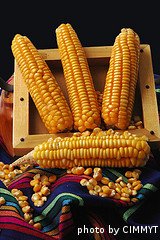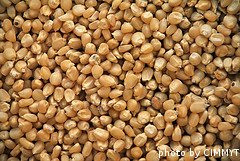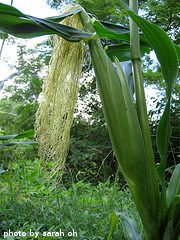How To Save Corn Seeds
Looking for information about how to save corn seeds? When saving corn seeds, you'll need to start with an heirloom variety of sweet corn. One of the more common heirloom varieties is Golden Bantam, which dates back more than 100 years. There are other heirloom sweet corn varieties available from many different seed companies and catalogs.
How To Save Corn Seeds Step By Step

Once you know you have an heirloom variety, the next step is to harvest the seeds (kernels). It's best to allow the ears of corn to dry and mature while still on the stalks. The husks should be brown and dry, along with the stalks. The kernels should be shriveled up and not contain any liquid at all. When you peel back the top of the husk, you're looking for hard seeds, not plump kernels.
As soon as the ears are dry and the
kernels have hardened up, you can remove the ear from the stalk. You don't want
to wait too long because a heavy rain can cause mold to develop.
Additionally, the longer you leave the corn on the stalk, the more
chances of ants, deer, racoons, squirrels or other pests getting into the kernels. You have to
walk a fine line - leave the ears on the stalk long enough to dry, but not so
long that something bad happens to them.
Once you've harvested the dry ears, go ahead and remove the husks and let the cobs finish drying in protected location like a garage or shed. It's best if you can turn the cobs every day or so, so the seed kernels get completely dry all around the cob. The kernels will turn quite hard when they are completely dry and you should be able to rub them off the cob with the palms of your hands. If the kernels are good and dry, they tend to release from the cob fairly easily.
When we rub the seed kernels off the cobs, we like to do it over a large box or dish pan, just so we don't lose any seeds. Keep in mind that dry corn seed will bounce easily, so try and pick a big enough container with high sides to better contain the seed kernels. If you do it over a baking sheet or something similar, you'll probably end up with just as many kernels on the floor as on the baking sheet.
Once you've got all the kernels off the cobs, you can toss the cobs into your compost pile or burn pile. You can also break up the cobs into pieces and use them as a fire starter. You can also soak them in water and then use them to smoke food. We find the smoke from dried and soaked corn cobs to be quite mild and very complimentary of delicate proteins like fish and cheese.

Once you have a pile of saved corn seeds, you can then put them inside an envelope and store them in a jar in your refrigerator. Make sure you label the envelope so you know what seeds it contains. This is especially important if you are saving more than one variety of corn seed. In this case, be sure to keep the saved corn seeds completely separate from each other and label them correctly.
If you are saving lots of different seeds, several
envelopes can fit inside one, quart-sized jar. It's also a good idea to
put a tablespoon of dry rice at the bottom of the jar, just to absorb
any moisture.
If you're saving corn seeds, it's a good idea to harvest seeds from at least 100
different corn plants to avoid inbreeding and keep your seed population
strong. Ideally, harvesting seed from 200+ plants is even better. If
you harvest from too few plants, the genetic base narrows and subsequent
crops will be less and less productive. If you aren't able to collect
seed kernels from enough plants, consider mixing them with another batch
of seed corn that you've previously saved or that you get from a
another grower.
Remember, it's best to save seeds from at least 100 different plants, not 100 different ears. If you are growing a variety that produces multiple ears per stalk and are interested in saving corn seeds, you have an advantage. You can harvest 1 ear from each stalk as soon as it matures and is ready for eating. Then, leave the other ear on the stalk to dry out and harvest the seeds from it when they've hardened up.

Click on the following links to learn more about growing sweet corn.
Click here to learn about planting corn
Click here for information about watering and fertilizing corn
Click here to learn about harvesting corn
Click here to move from our How To Save Corn Seeds page to our Growing Sweet Corn main page
Click here to go to our Home page